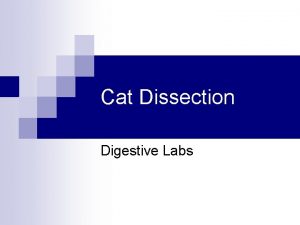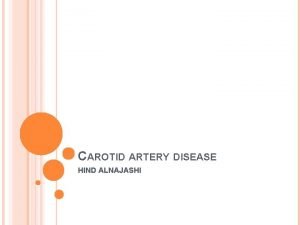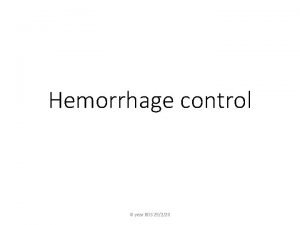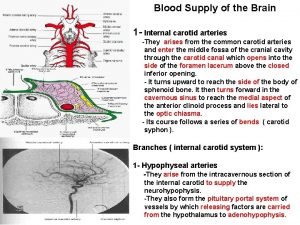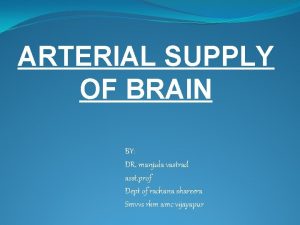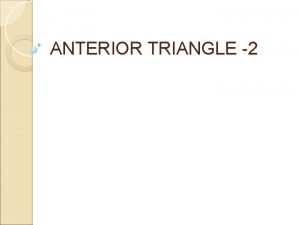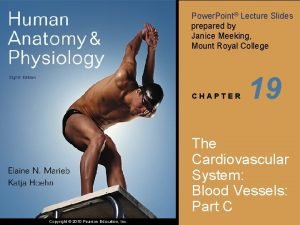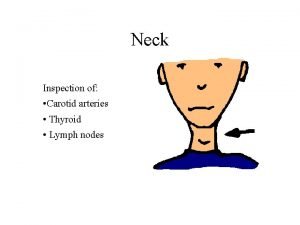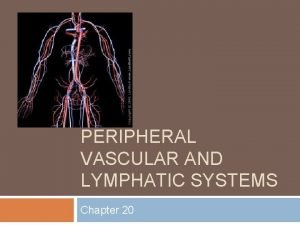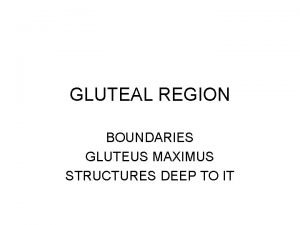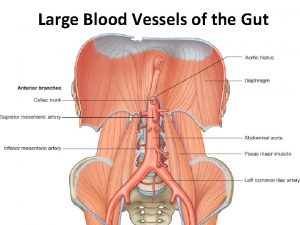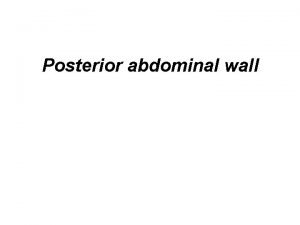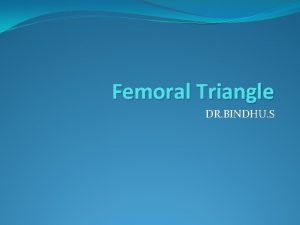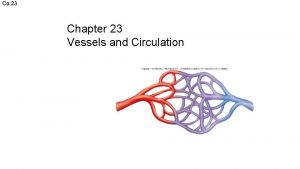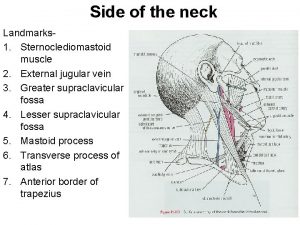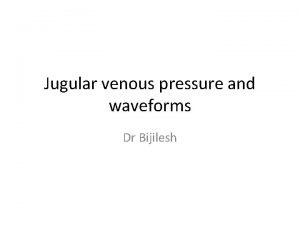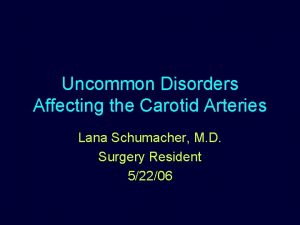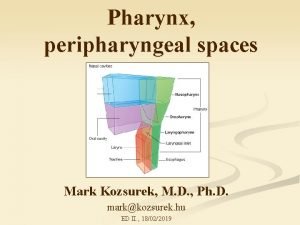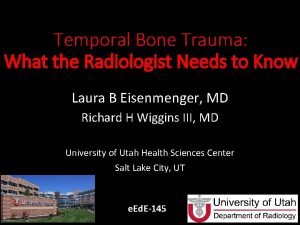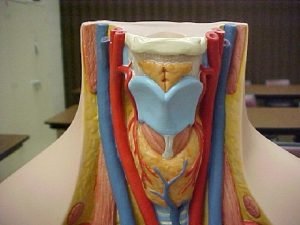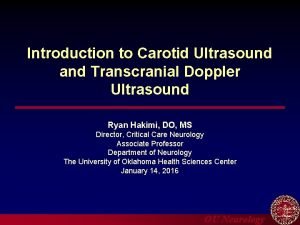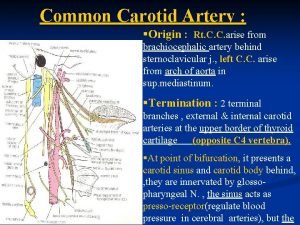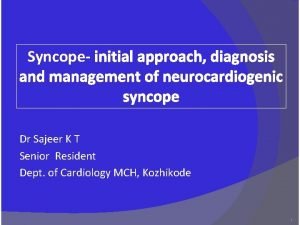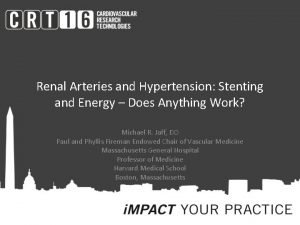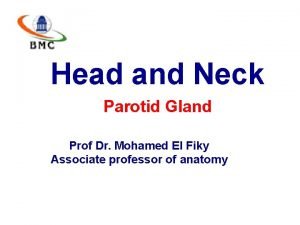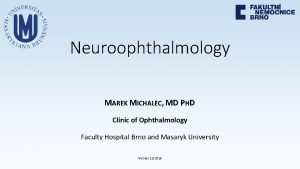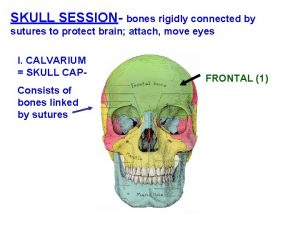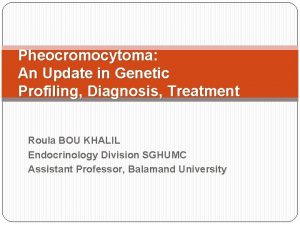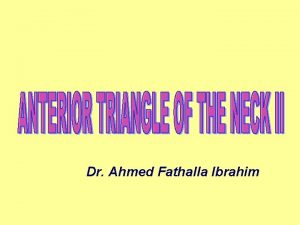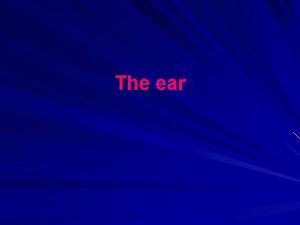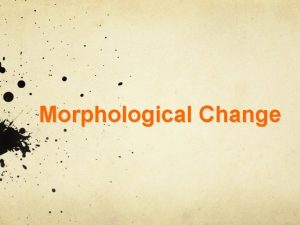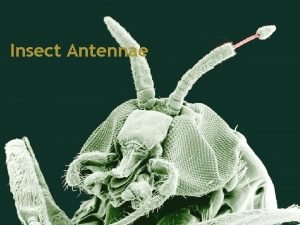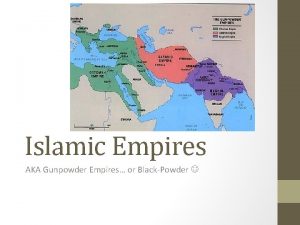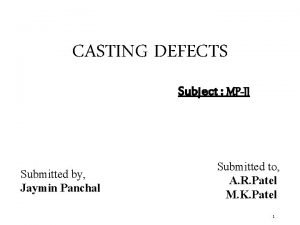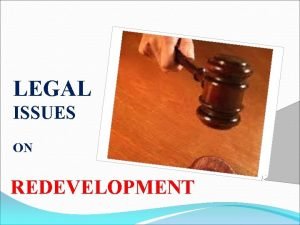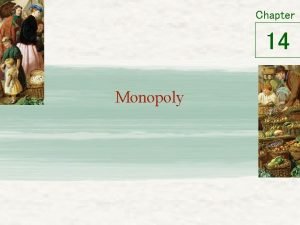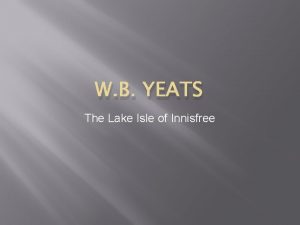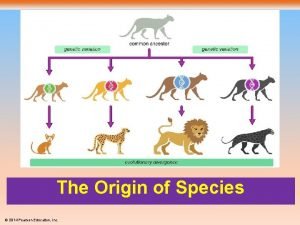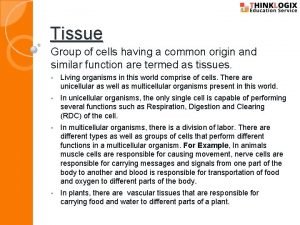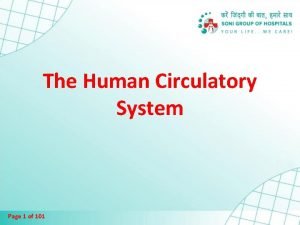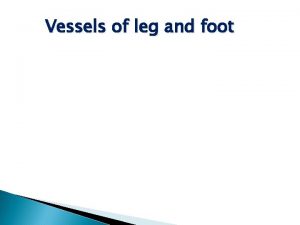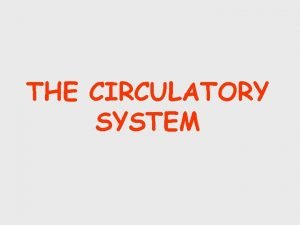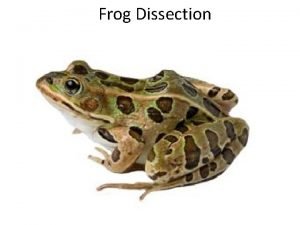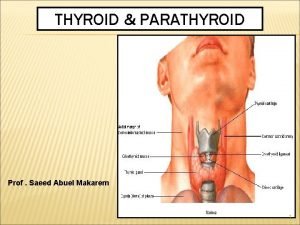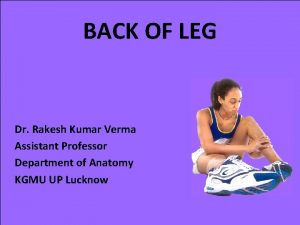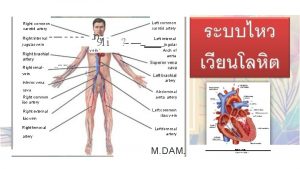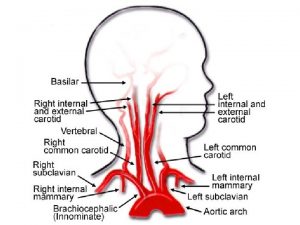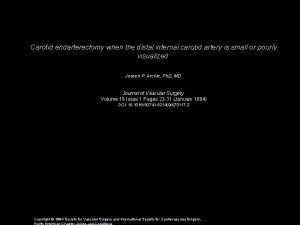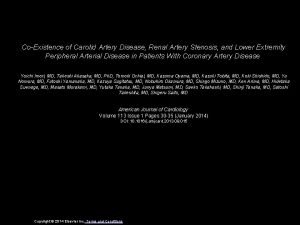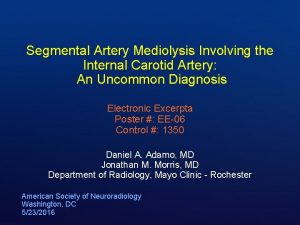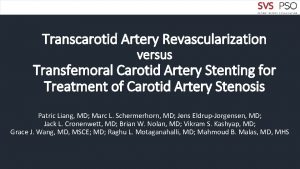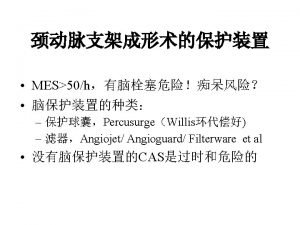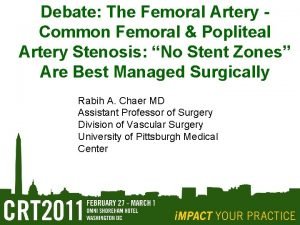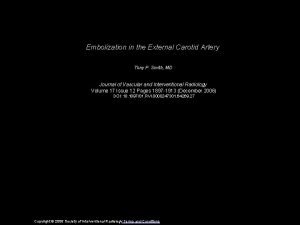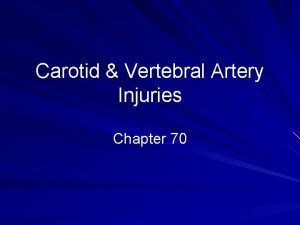Common Carotid Artery Origin Rt C C arise


































































- Slides: 66

Common Carotid Artery : §Origin : Rt. C. C. arise from brachiocephalic artery behind sternoclavicular j. , left C. C. arise from arch of aorta in sup. mediastinum. §Termination : 2 terminal branches , external & internal carotid arteries at the upper border of thyroid cartilage (opposite C 4 vertebra). §At point of bifurcation, it presents a carotid sinus and carotid body behind, , they are innervated by glossopharyngeal N. , the sinus acts as presso-receptor(regulate blood pressure in cerebral arteries), but the

Common Carotid Artery : §Origin : Rt. C. C. arise from brachiocephalic artery behind sternoclavicular j. , left C. C. arise from arch of aorta in sup. mediastinum. §Termination : 2 terminal branches , external & internal carotid arteries at the upper border of thyroid cartilage (opposite C 4 vertebra). §At point of bifurcation, it presents a carotid sinus and carotid body behind, , they are innervated by glossopharyngeal N. , the sinus acts as presso-receptor(regulate blood pressure in cerebral arteries), but the

Common Carotid Artery : ØIt is embedded within the carotid sheath with internal j. v. + vagus N. Relations : ØAnterolaterally : skin, fascia, sternomastoid, sternothyroid, sternohyoid & sup. belly of omohyoid. ØPosteriorly : transverse processes of lower 4 cervical vertebrae + prevertebral Ms. (longus colli & longus capitis) + sympathetic trunk. ØMedially : larynx, pharynx, trachea, esophagus & lobe of thyroid gland. ØLaterally : internal J. V. + vagus nerve.

External Carotid Artery : §It supplies structres in neck, face, , scalp , tounge & maxilla. §Origin : at superior border of thyroid cartilage (at C 4 vertebra), its pulsation can be felt. §It terminates in parotid gland behind neck of mandible by dividing into superficial temporal & maxillary arteries. §It lies at its beginning medial to Int. C. artery, then backward then laterally.

External Carotid Artery : §Relations : Antero-laterally (superficial relation) : 1 -skin, fascia. 2 -it is crossed by hypoglossal N. , stylohyoid + post. belly of digastric, Medially (deep relation) : 1 -internal C. artery (above). 2 -pharynx. 3 - Stylopgaryngeus muscle , glossopharyngeal N. & pharyngeal branch of vagus. (structures between int. & ext. arteries)

Branches of External Carotid Artery : §Superior thyroid artery. §Ascending pharyngeal artery. §Lingual artery. §Facial artery. §Occipital artery. §Posterior auricular artery. §Superficial temporal artery. §Maxillary artery.

Branches of External Carotid Artery : ØSuperior thyroid artery : -it gives off a branch to sternomastoid & superior laryngeal artery , which pierces thyrohyoid membrane with int. laryngeal N. ØAscending pharyngeal artery. ØLingual artery : -arise opposite the greater horn of hyoid bone , to enter submand. region and supply tongue. -it is crossed by hypoglossal N.

Branches of External Carotid Artery : ØFacial artery : -it arises from ext. C. artery just above the greater cornu of hyoid bone. It has a wavy course. -it ascends deep to and grooved post. part of submand. gland, then between gland body of mandible to pierce deep fascia at base of mandible to enter face. ØOccipital artery : -It supplies back of scalp. ØPosterior auricular artery : -arises at the level of upper border of post. belly of digastric to supply auricle. ØTerminal branches : inside substance of parotid gland behind neck of mandible, it terminates into Superficial temporal + Maxillary arteries.

Internal Carotid Artery : ØIt arises at the upper border of thyroid cartilage (C 4 vertebra). ØIt lies in the carotid sheath. ØIt enters the cranial cavity through the carotid canal. ØIt supplies the brain, eye, forehead, & nose ØIt has no branches in the neck. ØAtherosclerosis in the neck…. visual defect due to insufficient blood flow through central artery of retina. ØInsufficient blood flow in middle cerebral artey… motor & sensory loss.

Internal Carotid Artery : ØRelations : Anterolaterally (superficial) : -Skin &fascia. -Ant. border of sternomastoid. -Post. belly of digastric. Above the digastric : -Stylohyoid, stylopharyngeus, styloglossus + glossopharyngeal N. , pharyngeal branch of vagus, parotid gland, & external carotid artery (above). Posteriorly : sympathetic trunk, upper 3 cervical vertebrae. Medially : pharynx. Laterally : internal j. v. + vagus. N.

Subclavian artery : §Origin : right from brachiocephalic behind sterno-clavicular joint. , left from arch of aorta in sup. mediastinum. §Course : in the root of neck, it is divided into 3 parts by scalenus anterior. -1 st part extends from its origin to medial border of scalenus ant. -2 nd part lies posterior to this Ms. -3 rd part extends from lat. border of scalenus ant. to outer border of 1 st rib, where it becomes axillary Ar

1 st part of Subclavian artery : • Relations : Anteriorly : -common carotid , vagus, symp. trunk (ansa subclavia), int. j. v. & left phrenic N. Posteriorly : apex of lung & pleura, Rt. recurrent laryngeal. N §Branches : 1 -vertebral artery. . 2 -thyrocervical trunk. 3 -internal thoracic(mammary) artery.

Scalenus Anterior & Phrenic nerve : ØNote, the roots of phrenic N. lie laterally to scalenus anterior, but phrenic N. lies anterior to scalenus anterior.

1 -Vertebral Artery : §Course : -it passes in front of T. process of 7 th C. V. to ascend through foramina in transverse processes of upper 6 cervical vertebrae. -it emerges from T. process of atlas to pass behind its lateral mass, then pierces dura mater medially to enter vertebral canal and enter skull via foramen magnum to supply brain. Relations : -Anteriorly : C. C. artery and crossed by thoracic duct. Posteriorly : T. procees of 7 thc. v. & stellate ganglion. Branches : spinal & muscular.

2 -Thyro-cervical trunk : §It gives off 3 branches : 1 -inferior thyroid artery : ascends along med. border of scalenus ant. to level of cricoid cartilage (C 6 V. ) to reach post. border of thyroid gl. 2 superficial cervical & 3 - suprascapular arteries : they pass across scalenus anterior to enter post. triangle of the neck.

3 -Internal thoracic artery : §Arises from lower border of 1 st part of subclavian artery. §Enters thorax behind 1 st costal cartilage.

2 nd part of subclavian : §Relations : Anteriorly : scalenus ant. Posteriorly : cervical pleura & apex of lung. §Branches : one branch…. . Costo-cervical trunk : from its back. It gives off : 1 -sup. intercostal artery : gives rise to 1 st & 2 nd post. Intercostal arteries. 2 -deep cervical artery : to muscles of back of neck.

3 rd part of subclavian : §Extends from lateral margin of scalenus ant. to the outer border of 1 st rib , where it becomes axillary artery. §It lies in post. triangle of neck.

Subclavian vein : §It begins at outer border of 1 st rib as a continuation of axillary vein. §At medial border of scalenus ant. , it joins int. j. v. to form brachiocephalic vein. §It lies in lower anterior corner of post. triangle of neck , posterior & close to undersurface of medial 1/3 of clavicle, so it is a safe site of catheterization ( infraclavicular approach). §Its tributaries : Ext. J. V

Internal jugular vein : Course : §It receives blood from brain, face & neck. §It begins at jugular foramen as a continuation of sigmoid sinus. §It descends through the neck in the carotid sheath. §It unites with subclavian vein to form brachio-cephalic vein.

Tributaries of Internal jugular vein : §Inferior petrosal sinus : drains cavernus sinus, leaves skull via jugular foramen to join int. j. v. at its sup. bulb. §Pharyngeal veins. §Lingual vein. §Facial vein : leaves face superficially over submandibular gl. It joins ant. division of retromandibular v. to join the internal j. v. §Sup. thyroid vein : leaves sup. pole of thyroid into int. j. v. §Middle thyroid vein : leaves lobe of

Venous drainage of thyroid gland

External jugular vein : ØIt lies in superficial fascia deep to platysma, lying on sterno-mastoid. ØJust above the clavicle, it peirces deep fascia to drain into subclavian vein. v. Structures superficial to sternocleidomastoid are : skin, platysma, external j. v. , great auricular N. , transverse cervical N. & investing layer of deep cervical fascia.

Internal j. v. catheterization : ØInt. j. v. descends through neck from a point halfway between tip of mastoid process & angle of jaw to sternoclavicular joint. ØIn posterior approach, , the neddle & catheter are introduced into vein 2 fingers above clavicle at post. border of sternomastoid ØIn anterior approach, , the neddle & catheter are inserted into vein at the apex of triangle formed by sternal & clavicular heads of sternomastoid muscle.


Glossopharyngeal Nerve §Origin : Medulla Oblongata of Brain. §It has motor, sensory & parasymp. Fs. §Course & relations : -It has 2 sensory ganglia (sup. & inf. ) in the jugular foramen -It leaves skull through jugular foramen to descend in the upper neck within carotid sheath. -It leaves carotid sheath to pass between internal & external C. Ar. -It winds around stylopharyngeus Ms. between Sup. & middle constrictors of pharynx into the back of tongue deep to hyoglossus. -it terminates by dividing into terminal branches supplying m. m. of pharynx, tonsils, soft palate & post. 1/3 of tongue

Branches of Glossopharyngeal N. §Tympanic branch : arises from inf. ganglion, it has parasymp. secretomotor to parotid gland via auriculotemporal nerve. §Carotid branch : sensory to carotid sinus & carotid body. §Muscular : motor to Stylopharyngeus. §Pharyngeal branches (sensory) : to form the sensory part of pharyngeal plexus to supply m. m. of pharynx, tonsils, & soft palate. §Lingual terminal branches : for general & taste sensation of post. 1/3 of tongue.

Vagus Nerve §Origin : It emerges from M. O. to leave the skull with 9 th & 11 th Ns. through jugular F. §It has motor, sensory & parasympathetic Fs. §Course : §It has 2 sensory ganglia , superior within j. F. & inferior just below j. F. §At inf. ganglion, cranial root of accessory N. joins vagus N. and distributed in its pharyngeal & recurrent laryngeal branches.

Vagus nerve : §It descends in the upper part of neck within carotid sheath, firstly between int. j. v. & int. c. Ar. , then between Int. j. v. & C. C. Ar. §At the root of neck, it lies in front of to 1 st part of subclavian Ar. It passes through thorax and pierces diaphragm at esophageal opening to end in abdomen. §It innervates heart, / respiratory passages, / G. I. T. ( pharynx- left colic flexure), liver & pancreas.

Branches of Vagus nerve : From superior ganglion : 1 -meningeal branch. 2 -auricular br. for ext. acoustic meatus. From inferior ganglion : 3 -Pharyngeal br. : to form Motor part of pharyngeal plexus, to supply all Ms. of pharynx except Stylopharyngeus (by glossopharyngeal N. ), + all Ms. of soft palate except tensor veli palatini (by mandibular division of trigeminal). 4 -Superior laryngeal N. , it divides into : a-Internal laryngeal N. , pierces thyrohyoid membrane with sup. laryngeal artery, to supply sensory F. to m. m. of upper part of larynx above vocal fold.

Branches of Vagus nerve : 5 - cardiac branches : parasymp. , to end in cardiac plexus in the thorax. 6 - Right recurrent laryngeal N. : it hooks behind 1 st Subclavian artery to ascend in groove bet. trachea & esoph. to supply all Ms. of larynx (motor) except Cricothyroid , + m. m. of larynx (sensory), below vocal folds. 7 - left R. L. N. : it hooks around arch of aorta , behind ligamentum arteriosum, then ascends into neck in groove bet. trachea & esoph…. as Rt. R. L. N.

Testing the Integrity of Vagus nerve : ØDepends on testing the function of branches to pharynx, soft palate, & larynx. ØPharyngeal reflex or gag-reflex may be tested by touching lateral wall of pharynx with spatula causing the patient to gag due to contraction of pharyngeal Ms. ØInnervation of soft palate can be tested by saying ‘ah’, normally soft palate rises and uvula moves backward in the middle. ØLesion of innervation of larynx may reveal in horseness or absence of voice, and laryngoscopic examination may reveal paralysis of abductor muscles of larynx.

Accessory nerve §It is purely motor N. , formed by union of cranial & spinal roots. §Cranial root arises from M. O. §Spinal root arises from upper 5 cervical segments of spinal cord, It enters skull through the foramen magnum to join the cranial root within the cranial cavity. Distribution of Accessory N. §Both roots form the united trunk that emerges from jugular F.

Branches of Accessory nerve : §Cranial root separates from spinal root to join vagus at its inferior ganglion to distribute through its pharyngeal & laryngeal branches to supply Ms. of soft palate & pharynx (via pharyngeal plexus) and to Ms. of larynx (via R. L. N, except cricothyroid). §Spinal root pierces deep surface Distribution of Accessory N. of Sternomastoid to supply it , then emerges from posterior border of sternomastoid and crosses post. triangle, lying on the levator scapulae, finally passes deep to trapezius to supply it.

Testing the Integrity of Accessory nerve : ØAccessory N. supplies sternomastoid & trapezius Ms. by its spinal root. ØAske the patient to rotate head to one side against resistance causing contraction of sternomastoid of opposite side. ØAske the patient to shrug the shoulders causing action of trapezius, to compare the power on the 2 sides. Distribution of Accessory N.

Pharyngeal plexus of nerves ØIt lies on the outer wall of pharynx, mostly on the midlle constrictor. ØIt is formed of pharyngeal branches of glossopharyngeal N. (sensory part) + of vagus N. including fibres of cranial root of accessory (motor part) + of superior cervical sympathetic ganglion (sympathetic part), to supply pharynx & soft palate.

Hypoglossal Nerve §Origin : Arises from M. O. to leave skull via hypoglossal canal. §It is purely motor N. to the tongue. §Course : In its upper part, it is joined by a branch from cervical plexus (C 1 N. ) to supply thyrohyoid & geniohyoid. Distribution of Hypoglossal N. v later it leaves hypoglossal N. as descending branch of hypoglossal N.

Hypoglossal Nerve v It descends with the vagus N. between int. j. v. & int. C. artey, then crosses in front of internal & external carotid arteries. v Then it crosses in front of lingual artery to enter submandibular region.

Branches of Hypoglossal Nerve : §Meningeal branch. § N. to Thyrohyoid & Geniohyoid (via C 1). §Descending branch of hypoglossal C 1 leaves hypoglossal N. in front of carotid sheath to join the descending cervical N. (C 2, 3) of cervical plexus to form a loop of Ansa cervicalis. ØAnsa cervicalis loop supplies omohyoid, sternohyoid & sternothyroid Ms. Distribution of Hypoglossal N. §Muscular branches : to all Ms. of tongue, Except palatoglossus, (supplied by pharyngeal plexus)

Hypoglossal N. lesion ØAsk the patient to protrude his tongue : §A, Rt. &Lt. genioglossus muscle contract together. §B, tip of tongue is protuded anteriorly in the middle line. §C, lesion of hypoglossal N. on Rt. Side leads to atrophy & wrinkling of the tongue on the same side of lesion. §D, when asking patient to protrude the tongue, the tip deviates to side of the lesion.


Cervical Plexus : Formation : §It is formed by union of anterior rami of upper 4 cervical nerves, which form loops that lie in front of levator scapulae & scalenus medius. §It lies behind prevertebral layer of deep cervical fascia , int. J. V. , carotid sheath & Sternomastoid.

Branches of Cervical Plexus : §Cutaneous : lesser occipital (C 2), great auricular (C 2, 3), transverse cutaneous (C 2, 3)& supraclavicular nerves (C 3, 4), which enter post. triangle. §Muscular to 1 -prevertebral Ms. , 2 -sternomastoid (proprioceptive. C 2, 3), 3 -(C 3, 4) to supply : -diaphragm (phrenic N. ) -Trapezius & levator scapulae. 4 - C 2, 3 - inferior root of Ansa cervicalis it unites with superior root of Ansa cervicalis (C 1) to form loop of Ansa cervicalis to supply infrahyoid Ms. : omohyoid, sternohyoid & sternothyroid.

Branches of Cervical Plexus : §Communicating branches : - C 1 fibres join hypoglossal N. - Grey rami communicantes : from superior cervical sympathetic ganglion to C 1, 2, 3, 4 Formation & Branches of Ansa Cervicalis


Cervical part of Symp. Trunk : §It extends from base of skull , to the neck of 1 st rib, where it becomes the thoracic part. §It lies in front of cervical transverse processes, longus capitis & longus colli Ms. , behind carotid sheath medial to vagus N. & vertebral artery. § It has 3 ganglia. , superior, middle & inferior (cervico-thoracic or stellate ganglion).

Cervical part of Sympathetic Trunk ØAnterior relations : carotid sheath. ØPosterior relations : 1 -Cervical transverse processes. 2 -Longus capitis & longus colli (prevertebral muscles). ØLateral relations : 1 -vagus N. 2 -vertebral artery… (except inferior or stellate ganglion, which lies behind vertebral artery).

Superior Cervical Symp. Ganglion §It is the largest ganglion, lies at the level of C 2, 3 vertebrae. §Branches : 1 -Internal carotid nerve : it accompanies the int. c. Ar. into carotid canal , where it divides into branches to form internal carotid plexus. 2 -Gray rami communicates to the upper 4 anterior rami of cervical nerves 3 -External carotid nerve : it divides into branches to form symp. plexus around ext. C. artery & its branches. 4 -Cranial N. branches : which join 9 th , 10 th , & 12 th cranial

Superior Cervical Symp. Ganglion 5 -Pharyngeal branches : which unite with the pharyngeal branches of glossopharyngeal(9) & vagus(10) nerves to form the pharyngeal plexus. 6 -Superior cardiac branch : which ends in cardiac plexus in thorax.

Middle Cervical Symp. Ganglion : §It lies at level of cricoid cartilage (opposite 6 th C. V. ). §Branches : 1 -Gray rami communicates to anterior rami of 5 th & 6 th cervical nerves. 2 -Thyroid branches : which pass along inferior thyroid artery to form plexus to supply thyroid gland. 3 -Middle cardiac branch : which ends in cardiac plexus in thorax. 4 -Ansa suclavia : it forms a loop around 1 st part of subclavian artery (in front, then behind artery) to join inferior cervical symp. ganglion.

Inferior Cervical Symp. Ganglion (cevicothoracic or stellate ganglion) : §Usually, It is fused with 1 st thoracic ganglion to form stellate ganglion. §It lies in interval between transverse process of 7 th C. v. & neck of 1 st rib, behind vertebral artery. §Branches : 1 -Gray rami communicates to anterior rami of 7 th & 8 th cervical Ns. 2 -Arterial branches to subclavian & vertebral arteries to form plexuses. 3 -Inferior cardiac branch to join the cardiac plexus in the thorax.

Horner’s Syndrome : n n It includes : 1 -constriction of pupil (myosis), due to lesion of dilator pupillae supplied by sympathetic Fs. , which pass in the long ciliary N. 2 -ptosis (droping of upper eyelid), due to paralysis of smooth part of levator palpebrae superioris supplied by symp. fibres from superior cervical symp. ganglion. 3 -Enophthalmos (depression of eyeball into the orbital cavity), due to paralysis of symp. Fs. of internal carotid symp. plexus. Causes : Lesion of the sympathetic nerve supply to the orbit. 1 - lesion of cervical part of spinal cord. 2 - Traumatic injury to cervical part of symp. trunk. 3 - pressure on stellate ganglion by cervical rib or cancer.

Cervical rib : §The transverse process of 7 th cervical vertebra may be abnormally elongated or it may be separated to form a cervical rib. §It can causes pressure on symp. trunk, ( stellate ganglion), (in interval between cervical rib & neck of 1 st rib). § lower trunk of brachial plexus, & subclavian artery cross over cervical rib instead of 1 st rib.


Cutaneous branches of Cervical Plexus : v. Lesser occipital N. (C 2) : it passes along post. border of sternocleidomastoid. -it pierces deep fascia to supply : skin of neck & skin of lateral part of back of head v. Great auricular N. (C 2, 3) -it passes upwards, forwards, superficial to sternomastoid with external j. v. -it pierces deep fascia and divides into anterior & post. branches to supply : skin of face covering parotid gland, skin over angle of mandible (ant. branch) & skin covering mastoid process, and of lower part of auricle

Cutaneous branches of Cervical Plexus : v. Transverse cervical cutaneous Ns. (C 2, 3) : -it passes forwards superficial to sternomastoid, and pierces deep fascia. -it divides into upper & lower branches, to supply : skin of antero-lateral surface of neck. v. Supraclavicular Ns. (C 3, 4) : -it arises as a single trunk which divides into, medial, intermediate & lateral supraclavicular nerves. -they descend in post. triangle to pierce deep fascia above clavicle to supply : skin of lower part of neck, medial & intermediate branches supply skin of front of chest down to level of 2 nd rib (sternal angle), lateral branches supply skin of shoulder over upper ½ of deltoid.


Scalenus Anterior : ØIt is important landmark in the root of neck ØOrigin : transverse processes of 3 rd , 4 th , 5 th & 6 th cervical vertebrae. ØInsertion : scalene tubercle on inner border of 1 st rib & a ridge on upper surface of 1 st rib. ØN. Supply : anterior rami of 4 th , 5 th , & 6 th cervical nerves. ØAction : 1 -elevation of 1 st rib (during deep inspiration). 2 when acting from below, it laterally flexes & rotates cervical part of vertebral column.

Relations of Scalenus Anterior : ØAnteriorly : 1 -prevertebral layer of deep cervical fascia. 2 -phrenic nerve, deep to this fascia 3 -superficial cervical & suprascapular arteries. 4 -internal j. v. & subclavian v. ØPosteriorly : 1 -subclavian artery (2 nd part). 2 -brachial plexus. 3 -scalenus medius. 4 -cervical pleura.

ØNote, the phrenic N. deep to prevertebral layer of deep cervical fascia, + internal jugular vein + transverse cervical artery are the anterior relations to scalenus anterior. ØNote, scalenus medius + brachial plexus are the posterior relations to scalenus anterior.

Relations of Scalenus Anterior : ØMedially : 1 -vertebral artery & vein. 2 -inferior thyroid artery & thyro -cervical trunk. 3 -sympathetic trunk & thoracic duct on left side. ØLaterally : 1 - brachial plexus. 2 - subclavian artery (3 rd part). 3 - roots of phrenic N.

Scalenus Anterior & Phrenic nerve : ØNote, the roots of phrenic N. lie laterally to scalenus anterior, but phrenic N. lies anterior to scalenus anterior. ØThe right phrenic N. enters thorax in front of scalenus anterior but the left phrenic enters thorax in front of left subclavian artery.

Phrenic Nerve ØOrigin : from cervical 3, 4, 5 nerves. ØIt is the only motor nerve supply to diaphragm. ØIt has also sensory fibres for diaphragm + pleura & peritoneum covering upper & lower surfaces of central part of diaphragm. ØThe right phrenic enters thorax in front of scalenus anterior, but the left one enters thorax in front of subclavian artery. ØAnterior relations : prevertebral layer of deep cervical fascia, internal jugular vein , superficial cervical & suprascapular arteries, and thoracic duct + beginning of brachiocephalic vein on the left. . ØPosterior relations : scalenus anterior, subclavian artery & cervical dome

Scalenus Medius : ØOrigin : transverse process of atlas & next 5 cervical vertebrae. Or (from transverse. processes of all cervical vertebrae). ØInsertion : upper surface of 1 st rib behind groove for subclavian artery. ØN. supply : anterior (ventral) rami of all cervical nerves. ØAction : (as scalenus anterior) 1 -it assists in elevating 1 st rib. 2 -it laterally flexes & rotates cervical part of vertebral column.

Scalenus Posterior : ØIt may be absent or blended with scalenus medius. ØOrigin : transverse processes of lower cervical vertebrae. ØInsertion : outer surface of 2 nd rib. ØN. supply : anterior rami of lower cervical nerves. ØAction : 1 -elevation of 2 nd rib. 2 -lateral flexion & rotation of cervical vertebral column, when active from below.

 Cat trachea
Cat trachea Arteries
Arteries External carotid artery terminal branches
External carotid artery terminal branches Amourosis fugax
Amourosis fugax Incisive defintion
Incisive defintion Blood supply to brain
Blood supply to brain Brain
Brain Carotid sheath contents
Carotid sheath contents Phrenic vein
Phrenic vein Carotid node
Carotid node Carotid artery pulse
Carotid artery pulse Superior mesenteric artery origin
Superior mesenteric artery origin Gluteal artery
Gluteal artery Knee blood supply
Knee blood supply Superior rectal artery is a branch of
Superior rectal artery is a branch of Porto systemic anastomosis
Porto systemic anastomosis Femoral canal structures
Femoral canal structures The radial and ulnar veins merge to form the
The radial and ulnar veins merge to form the Contents of carotid sheath
Contents of carotid sheath Jvp vs carotid pulse
Jvp vs carotid pulse Nerve ganglia
Nerve ganglia Lana schumacher md
Lana schumacher md Lingual tonsil
Lingual tonsil Carotid cochlear dehiscence
Carotid cochlear dehiscence Left subclavian vein
Left subclavian vein Transcranial ultrasound
Transcranial ultrasound Carotid terminus
Carotid terminus Carotid sinus hypersensitivity
Carotid sinus hypersensitivity Carotid sinus
Carotid sinus Parotid gland
Parotid gland Carotid anatomy
Carotid anatomy Combat lifesaver powerpoint
Combat lifesaver powerpoint Carotid cavernous fistula
Carotid cavernous fistula Zygomaticofacial foramen
Zygomaticofacial foramen Organ of zuckerkandl
Organ of zuckerkandl Carotid sheath contents
Carotid sheath contents Modiolus of cochlea
Modiolus of cochlea Carotid cana
Carotid cana Simple past drink
Simple past drink Oh church arise
Oh church arise Pair of antennae
Pair of antennae How to arise and shine
How to arise and shine Why do territorial conflicts arise among religious groups
Why do territorial conflicts arise among religious groups Let praise arise
Let praise arise Arise to greet the lord of light
Arise to greet the lord of light How did the ottoman safavid and mughal empires arise
How did the ottoman safavid and mughal empires arise Why might fishing disputes arise in the region
Why might fishing disputes arise in the region Arise precision casting
Arise precision casting Arise due to
Arise due to How does monopoly arise?
How does monopoly arise? The lake isle of innisfree
The lake isle of innisfree Describe the conditions under which new species may arise.
Describe the conditions under which new species may arise. Tissue is a group of cells having
Tissue is a group of cells having What are the factors for 54
What are the factors for 54 Highest common factor of 12 and 42
Highest common factor of 12 and 42 Factors of 18
Factors of 18 Common anode and common cathode
Common anode and common cathode Highest common factors and lowest common multiples
Highest common factors and lowest common multiples Factor tree of 48
Factor tree of 48 End artery meaning
End artery meaning Sternal border
Sternal border Pulse artery
Pulse artery Dorsalis pedis vein
Dorsalis pedis vein Difference between artery and vein in tabular form
Difference between artery and vein in tabular form Frog organs and functions
Frog organs and functions Superior thyroid artery is a branch of
Superior thyroid artery is a branch of Cruris
Cruris
